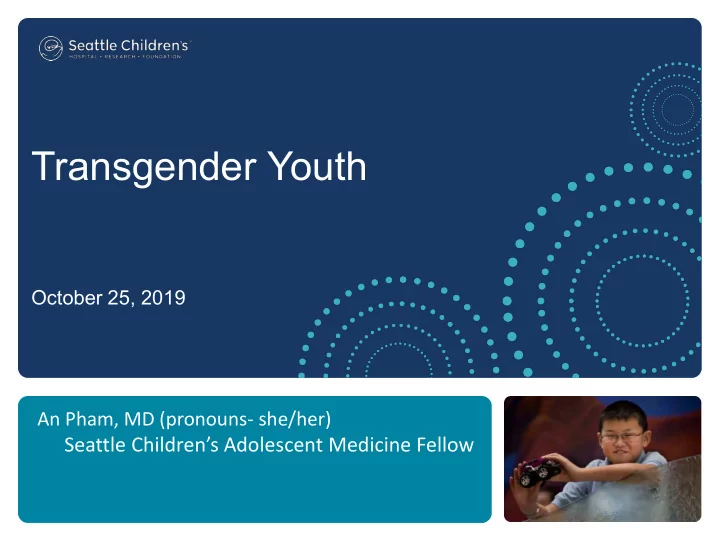

Transgender Youth October 25, 2019 An Pham, MD (pronouns- she/her) • Seattle Children’s Adolescent Medicine Fellow
Disclosures • No conflict of interest to report. • No commercial support or sponsorship, nor is it co- sponsored. • Discussing the off-label use of medications for treatment of gender dysphoria.
Terms and Concepts
Spectrum of Gender and Sex Adapted from: The Genderbread Person, by www.ItsPronouncedMetrosexual.com See also: The Gender Unicorn, http://www.transstudent.org/gender
Definitions • Cisgender: someone whose gender identity is the same as the sex they were assigned at birth. • Transgender: someone whose gender identity is different from the sex they were assigned at birth. For example: • Transfeminine: Someone assigned male at birth, who now identifies their gender as female • Transmasculine: Someone assigned female at birth, who now identifies their gender as male • Non-binary: someone whose gender identity is not entirely male nor entirely female. • Gender diverse : Describes people with gender behaviors, appearances, or identities that are incongruent with those culturally assigned to their birth sex
Pronouns Subjective Objective Possessive Example He Him His He is in the waiting room. The doctor is ready to see him. That chart is his. She Her Hers She is in the waiting room. The doctor is ready to see her. That chart is hers. They Them Theirs They are in the waiting room. Their doctor is ready to see them. That chart is theirs. Ze Hir Hirs Ze is in the waiting room. The doctor is ready to see hir. That chart is hirs. Source: Fenway Institute’s “Providing Affirmative Care for Patients with Non-binary Gender Identities”
They/them pronouns Don’t worry… You already know how to use the singular “they”: “Oh no, someone left their cell phone.” “Shoot, I wonder if they’ll miss it?” “Of course they will. It’s their phone.”
Common Misconception • Orientation does not always equal behavior Sexual • Majority of women who Orientation have sex with women (53- 99%) have had sex with men • Gender identity and orientation can be Sexual confusing Behavior • Decrease ambiguity Gender when asking patient Identity/ Expression
Endless things are gendered from before birth to adulthood
We use gendered language all the time Excuse me sir , how much is this? Your daughter is so cute Think about all the times in class that you, a classmate, or a professor made an assumption about a person’s gender?
Why does this matter? • Gendering is very traumatic for transgender people particularly during adolescence! • “Your gender is like drinking water , when you drink water it is not supposed to taste like anything. But when it tastes different, you notice. That is what being transgender is like: when your water tastes different.” - 18 year old transgender youth
Traumatic adolescence? What’s the big deal?
Health disparities • Transgender youth experience higher levels of bullying, discrimination, violence, family and peer rejection, and homelessness. • Increased risk of issues including substance abuse, depression, and anxiety. • Nine-fold increased risk of eating disorders. • More than 40% of transgender young people attempt suicide. Olson J et al. 2011. Arch Pediatr Adolesc Med. Spack NP et al. 2012. Pediatrics. Diemer et al. 2015. J Adolesc Health.
Health factors in transfeminine people 151 transfeminine youth LA & Chicago Ever sex work 70 % Ever HIV tested 85 % of 19% (24) HIV+, few in care Ever homeless 43% Ever incarcerated 52% Street Drugs 52% Poverty (<$1000/month) 70%
Resilience • Many transgender youth lead normal, productive lives • Usually develop resilient adaptations to social biases and mistreatment • Many develop and possess remarkable strength and self-determination
Protective factors • Importance of support from family, schools, & providers • Trans youth who are supported by their families have similar levels of anxiety and depression compared to their cisgender siblings and peers • Reduced depression and suicidality among trans youth who were able to use their chosen name in various settings Olson KR et al. “Mental Health of Transgender Children Who Are Supported in Their Identities. 2016. Pediatrics. Russel ST et al. “Chosen Name Use Is Linked to Reduced Depressive Symptoms, Suicidal Ideation, and Suicidal Behavior Among Transgender Youth. 2018. Journal of Adolescent Health.
Clinical care: gender affirming care Puberty blockers Social and (GnRH analogs) emotional support Cross-sex hormones Affirming care Surgeries environment
Gender Affirmation Rafferty J, et al Ensuring Comprehensive Care and Support for Transgender and Gender-Diverse Children and Adolescents. Pediatrics. 2018;142(4): e20182162
Medical transition for youth is complicated: Parental concerns • How do I know they are actually transgender? • What if this is just a phase? • Why can’t we wait until they have finished puberty or they are an adult before we talk about medical transition? What if my child regrets this?
AAP Policy Statement
Questions?
Recommend
More recommend